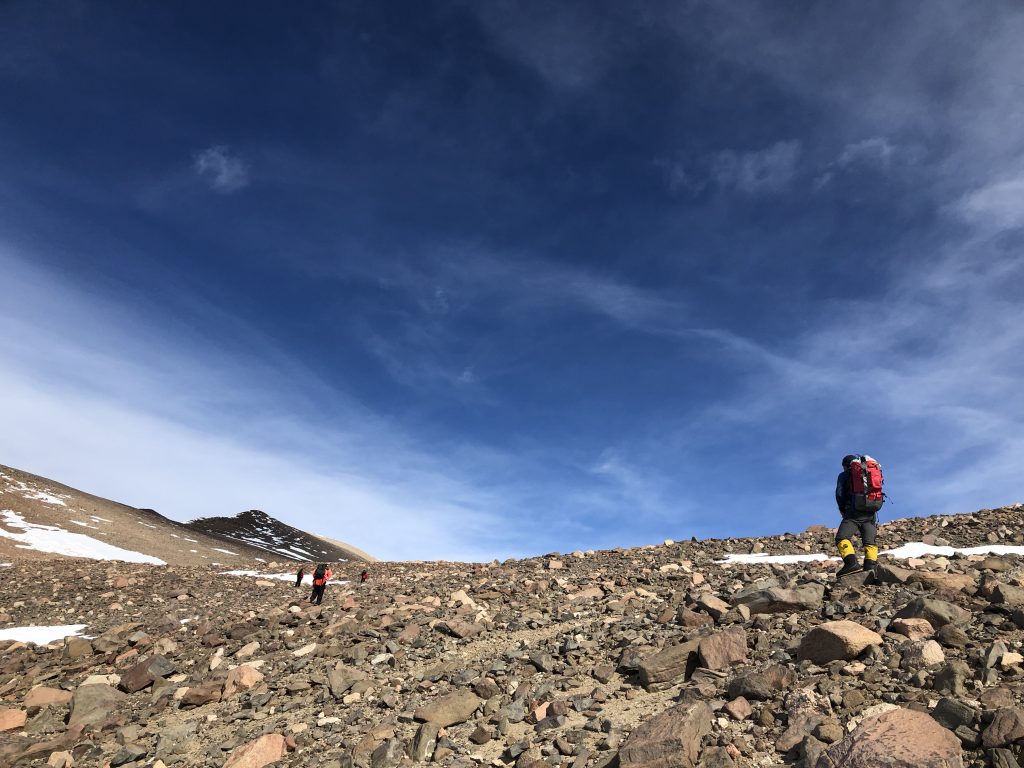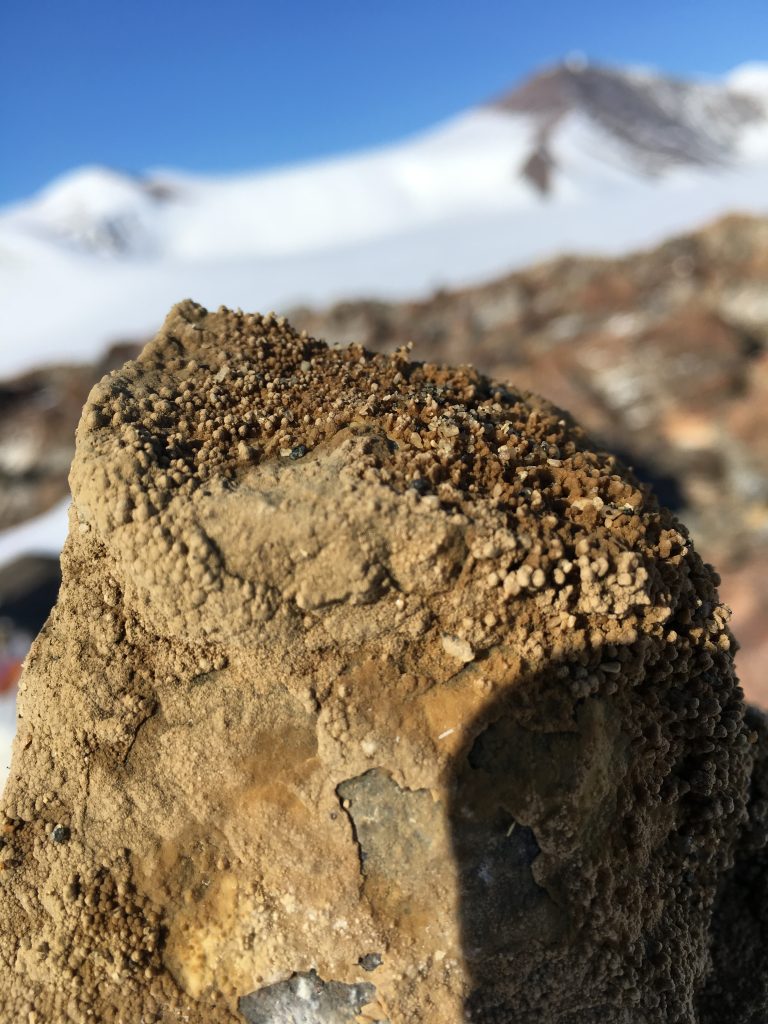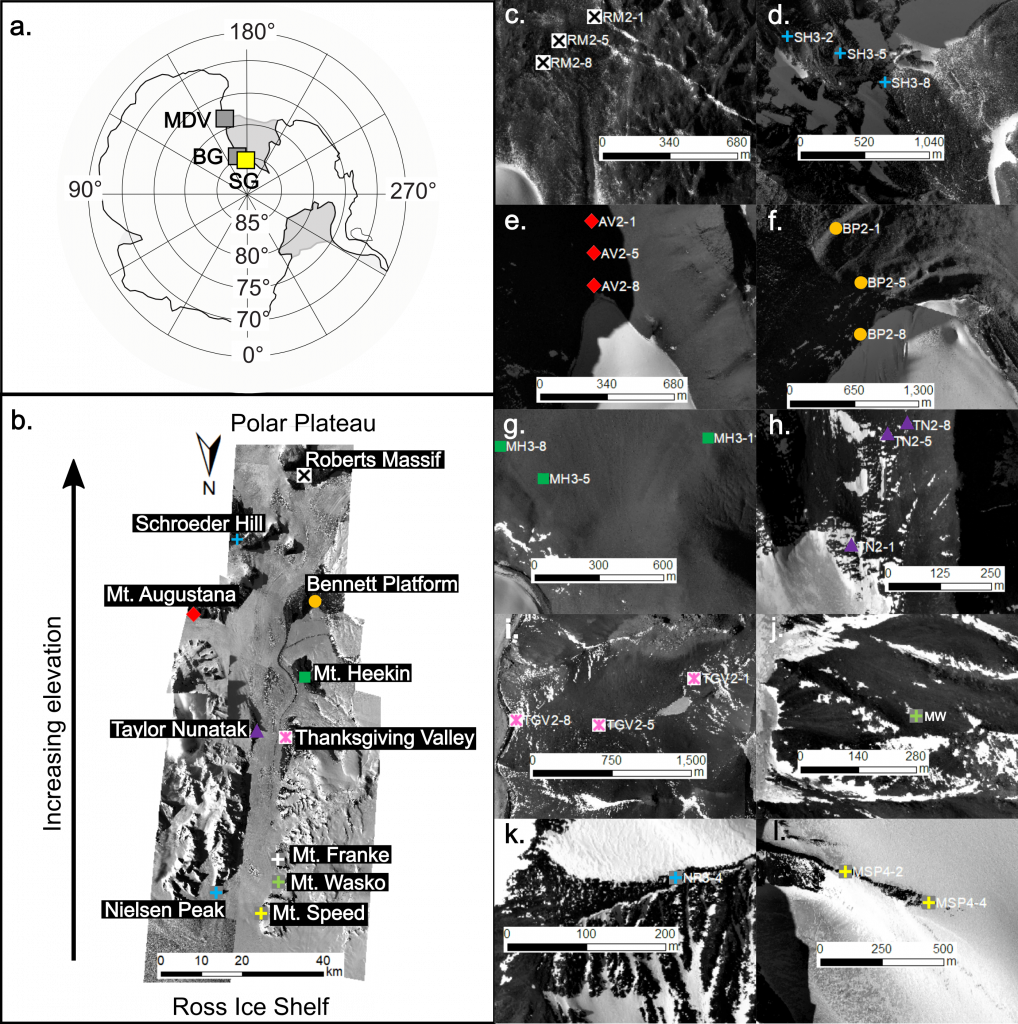Research area #2: Transantarctic Mountains
Shackleton Glacier
Though the majority of the Antarctic continent is covered by ice, portions of Antarctica, mainly in the McMurdo Dry Valleys and the Transantarctic Mountains (TAM), are currently ice-free. The soils which have developed on these surfaces have been re-worked by the advance and retreat of glaciers since at least the Miocene. They are generally characterized by high salt concentrations, low amounts of organic carbon, and low soil moisture in a polar desert regime.

Hyper-arid soils from the Transantarctic Mountains
Climate, species interactions, habitat suitability (soil geochemistry) and dispersal drive the structure and functioning of ecological communities; less understood is the relative importance of these factors in shaping how terrestrial ecosystems respond to climate-driven environmental changes, particularly during glacial-interglacial transitions.

Collembola (white, near shadow) found near Mt. Speed
This is a collaborative project with PIs from Brigham Young University, University of Colorado Boulder, Colorado State University, University of Waikato and Polar Knowledge Canada, and The Ohio State University. The overarching objective is to comprehensively characterize the functional, taxonomic, biotic and abiotic drivers of soil ecosystems in the context of their response to deglaciation since the last glacial maximum in the Shackleton Glacier region.
We seek to evaluate the following questions:
- Could high elevation soil ecosystems have served as refugia for soil biota through the Pleistocene?
- How have Antarctica’s terrestrial biota responded to climate-driven changes since the LGM?
- As the outlet glaciers of the TAM receded, how were contemporary terrestrial ecosystems restructured?
- What biotic and abiotic drivers were responsible for observed differences in contemporary biodiversity, ecosystem structure, and functioning?
I focused on the geochemical characterization of soils from the Shackleton Glacier region to answer the following questions:
- What are of types of salts and sources of salts in Central Transantarctic Mountain hyper-arid soils?
- What are the relative terrestrial surface exposure ages of soils we collected?
- What are the distributions of water-soluble nutrients?
- Can geochemical and environmental gradients be used to predict habitat suitability?

Map of Antarctica highlighting the Shackleton Glacier (SG; yellow box) relative to the McMurdo Dry Valleys (MDV) and Beardmore Glacier (BG) (grey boxes) (a). The Shackleton Glacier is the focus of this study and flows from the Polar Plateau to the Ross Ice Shelf (b). Soil samples were collected from features along the glacier: Roberts Massif (c), Schroeder Hill (d), Mt. Augustana (e), Bennett Platform (f), Mt. Heekin (g), Taylor Nunatak (h), Thanksgiving Valley (i), Mt. Wasko (j), Nilsen Peak (k), Mt. Speed (l). Images of the Shackleton Glacier were acquired from the Polar Geospatial Center (PGC).
From late December 2017- early January 2018 we conducted a field campaign to test hypotheses associated with each of these questions. 220 surface soil samples and 25 depth profile samples were collected from eleven ice-free areas along the Shackleton Glacier. A subset of 27 samples were leached at a 1:5 soil to deionized (DI) water ratio and analyzed for stable isotopes of water-soluble NO3- (δ15N and Δ17O) and SO42- (δ34S and δ18O), and seven soils were analyzed for δ13C and δ18O of HCO3 + CO3 to understand the sources and cycling of salts in TAM soils. The depth profiles and a subset of surface soil (21) samples were analyzed for concentrations of meteoric 10Be and/or water-soluble NO3- to estimate relative surface exposure ages along the length of the Shackleton Glacier. Finally, water-soluble ion data from all 220 samples were correlated with geography and geomorphology to elucidate geochemical trends and gradients. The relationship between geochemistry and geography was further used to predict/estimate geochemical gradients in the TAM using interpolation and machine learning techniques.
Collectively, these measurements and data show that atmospheric deposition is an important source of water-soluble anions, which have possibly been accumulating in some soils since at least the Pleistocene. Soils near the terminus of the Shackleton Glacier and near the glacier margins are younger than those further south towards the Polar Plateau and further inland. These soils have nutrient and salt concentrations most suitable for soil invertebrates. The geochemistry of TAM soils is related to geography, glacial history, and the present and past availability of liquid water, and these parameters can be used to effectively predict/model geochemical gradients.
These findings will greatly aid in our collective understanding of habitat suitability and refugia for Antarctic terrestrial systems, and may help predict how ecosystems will respond to future climate transitions.
Future Projects
I am currently collaborating on an NSF proposal to characterize the role of glacier-driven chemical weathering of dust in controlling glacier meltwater chemistry in the McMurdo Dry Valleys.
Please contact me for additional details.
Funding Agencies
This work was supported by the National Science Foundation under grants OPP 1115245 (awarded to W.B. Lyons) and GRFP 60041697 (awarded to M.A. Diaz).
Additional supporting agencies include the Geological Society of America, International Association of Geochemistry, and Purdue AMS Facility.
Partners/Collaborators
This is a joint project with Brigham Young University, University of Colorado Boulder, Colorado State University, University of Waikato and Polar Knowledge Canada, and The Ohio State University.
Research Papers
- Exploring the boundaries of microbial habitability in soil. https://doi.org/10.1029/2020JG006052
- Relative terrestrial exposure ages inferred from meteoric-10Be and NO3- concentrations in soils along the Shackleton Glacier, Antarctica. https://doi.org/10.5194/esurf-2020-50
- Geochemical zones and environmental gradients for soils from the Central Transantarctic Mountains, Antarctica. https://doi.org/10.5194/bg-18-1629-2021
- Stable isotopes of nitrate, sulfate, and carbonate in soils from the Transantarctic Mountains, Antarctica: A record of atmospheric deposition and chemical weathering. https://doi.org/10.3389/feart.2020.00341
